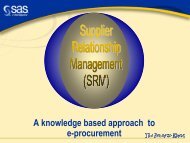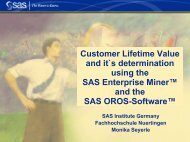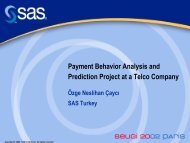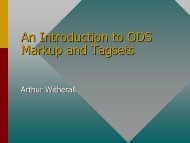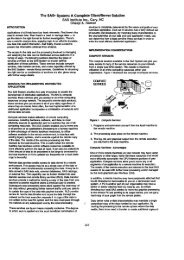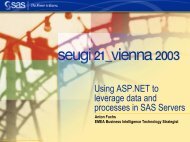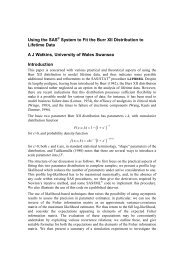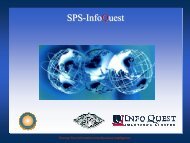Sugi-92-243 Dukovic.pdf - sasCommunity.org
Sugi-92-243 Dukovic.pdf - sasCommunity.org
Sugi-92-243 Dukovic.pdf - sasCommunity.org
You also want an ePaper? Increase the reach of your titles
YUMPU automatically turns print PDFs into web optimized ePapers that Google loves.
AN INTERACTIVE SAS/A~ SYSTEM FOR ASSESSING BIOEQUIVALENCE<br />
Deborah <strong>Dukovic</strong>, Sterling Winthrop, Inc.<br />
ABSTRACT<br />
and time to reach peak concentration (Tmax).<br />
Testing the equivalence of treatments in a two-period crossover<br />
design setting occurs often in the pharmaceutical industry. These<br />
studies usually compare the rate and extent of absorption of two<br />
different drugs or two formulations of the same drug, where one is<br />
the accepted standard therapy. The commonly accepted rule for<br />
concluding bioequivalence requires the 90% confidence interval for<br />
the mean tesVstandard ratio of AUG and Cmax to be contained in<br />
the range (80,120)%. Sample size is usually determined based on<br />
meeting this criterion.<br />
In order to improve efficiency and consistency in the analysis and<br />
reporting of data from bioequivalence trials, a SAS/ A~ application<br />
system for analyzing data from a two-period, two-treatment<br />
crossover design was created. The system contains four main<br />
sections: sample size/power, analysis, bioequivalence and utility.<br />
With the expanded capabilities of SASIAF in Version 6 and the use<br />
of SCL, the system is very powerful, yet extremely user friendly.<br />
This paper first presents a brief overview of the design and<br />
analysis of data from a two-period crossover study. Primary focus<br />
is then directed to the interactive SAS/ AF system and those<br />
functions of the system related to the analysis of the data and the<br />
assessment of bioequivalence.<br />
Sequence<br />
Period<br />
S<br />
T<br />
2<br />
T<br />
Figure 1 Two-period, two-treatment crossover<br />
design<br />
TYPICAL ANALYSIS<br />
Data from a two-treatment, two-period crossover study are typically<br />
analyzed using an analysis of variance (ANOVA) model with terms<br />
for sequence, subject nested under sequence, treatment and<br />
period. The carryover effect is, essentially, the sequence effect,<br />
which is tested against the between subjects residual sum of<br />
squares. Assuming the sequence effect (carryover) is not<br />
significant, the basic ANOVA, with an equal numberof subjects (n)<br />
in each sequence, takes the form shown in Table 1.<br />
S<br />
INTRODUCTION<br />
Is it often the case that a pharmaceutical company will try to<br />
develop a different formulation of a currently approved drug or<br />
develop a different drug that is at least as effective as the standard<br />
treatment, but is better in some facet, such as less side effects. In<br />
such a case, the company is required to demonstrate that the two<br />
treatments are bioequivalent ("same" rate and extentof absorption).<br />
Typically, a two-period, two-treatment crossover study is conducted<br />
for th is purpose.<br />
Source of<br />
variation<br />
Sequence<br />
Subject(sequence)<br />
Treatment<br />
Period<br />
Error<br />
Total<br />
Degrees of<br />
freedom (d.f.)<br />
1<br />
2(n·l)<br />
1<br />
2(n-l )<br />
4n-1<br />
STUDY DESIGN AND OBJECTIVES<br />
In a two-period crossover design (Figure 1), subjects in one group<br />
each receive a single dose of the standard treatment, while<br />
subjects in another group receive the test treatment. After a<br />
~washoue period, during which all traces of the drug are expected<br />
to have disappeared from the body, each subject receives a dose<br />
of the alternate formulation (period two). Thus, there would be,<br />
say, n subjects in sequence group 1 who receive the standard<br />
treatment in the first period and the test treatment in the second<br />
period. In addition, there would be m (usually equal to n) subjects<br />
in sequence group 2 who receive the test treatment first and then<br />
the reference treatment. This design is appealing in that fewer<br />
subjects are usually required than would be necessary for a<br />
paraUel-groups design and each subject serves as hislher own<br />
control.<br />
The objective of the two-period crossover is usually the<br />
determination of the equivalence of two treatments. Equivalence<br />
here implies that the rate and extent of absorption of the two<br />
treatments is essentially the Msame M • These absorption<br />
characteristics are usually quantified in practice by means of area<br />
under the blood level curve (AUG), peak drug concentration (Cmax)<br />
Table 1 ANOVA for two-period, two-treatment<br />
crossover design with n subjects per sequence<br />
Some have given justification for automatically performing a<br />
logarithmic (In) transformation on AUC and Gmax data before<br />
performing the ANOVA. However, it is usually informative to<br />
analyze the data both with and without transformation and examine<br />
the residuals of each. One nice feature of In transforming is that<br />
the confidence intervals constructed following the ANOVA will be<br />
on ratios of means rather than differences, which fits into the<br />
proportional form in which the FDA gives its rule for accepting<br />
equivalence (±20%).<br />
ASSESSMENT OF BIOEQUIVALENCE<br />
Many methods for assessing bioequivalence have been proposed<br />
over the years, some of which have been totally discarded and<br />
others of which are still being studied and compared. Specifics of<br />
the theory and methods used to test bioequivalence will not be<br />
presented here. Anderson and Hauck (1983, 1984), Fluehler, etal<br />
1423
(1981, 1983), locke (1984), Mandallaz and Mau (1981), Metzler<br />
(1974, 1983, 1988, 1989), Rocke (1984, 1985), Rodda and Davis<br />
(1980), Schuirmann (1987,1989), Selwyn and Hall (1984) and<br />
Westlake (1972, 1976, 1981, 1988) are some of the available<br />
references on the topic.<br />
In some cases, the assessment of bioequivalence involves<br />
estimating either the difference (test-standard) or ratio<br />
(test/standard) of treatment means and forming a confidence<br />
interval for the estimate. Equivalence is accepted if the confidence<br />
interval is completely contained in some specified interval, (9 p 9:;J<br />
In other cases, actual hypothesis tests are carried out and<br />
bioequivalence is decided if the p-value of the null hypothesis is<br />
less than some specified value, say 0.1. In still other cases, a<br />
Bayesian posterior probability that the true value of the estimate<br />
(difference or ratio) is contained in Some specified interval (8 1 ,9 2 )<br />
is calculated, based on the sample values, and bioequivalence is<br />
accepted if the posterior probability is greater than some level, say<br />
0.95.<br />
The current FDA recommended procedure is the two one-sided<br />
testing approach which is operationally equivalent to construction<br />
of a (1-2a.)100% confidence interval for the ratio of formulation<br />
means. For non-transformed data, the confidence interval for the<br />
ratio is commonly constructed by either dividing the endpoints of<br />
the confidence interval for the difference in formulation means by<br />
the reference sample mean (FDA method, see Report by the<br />
Bioequivalence Task Force on recommendations from the<br />
bioequivalence hearing conducted by the FDA, January 1988) or<br />
by using Fieller's theorem. In addition, an exact method was<br />
described by Locke (1984). If the data has undergone a<br />
logarithmic transformation, a confidence interval for the ratio of test<br />
to standard treatment can be easily calculated by exponentia~ng<br />
the estimated difference and confidence interval endpOints.<br />
SAS/AF SYSTEM<br />
With the rather frequent occurrence of two-period crossover studies<br />
for testing bioequivalence in our work environment, it was decided<br />
to create an interactive, user-friendly SASJAF system to provide a<br />
complete, start to finish analysis of such data; for use by<br />
statisticians and non-statisticians alike. SAS/GRAPH@> and<br />
SASISTAl" are utilized along with SAS/FSp·, SAS/AF and base<br />
SA~ software. With this system in place, the time it takes to<br />
analyze a set of data and provide a written report is greatly<br />
reduced. Furthermore, overall conSistency in reports for different<br />
data sets is attained.<br />
The main menu of the SAS/AF system, displayed in Figure 2,<br />
offers six choices. The SCl block fUnction was used to create this<br />
selection screen.<br />
I MAIN MENU I<br />
IS~ps~_1<br />
I D",ision<br />
Aules I<br />
I<br />
Ulililies<br />
I "" I I<br />
Exil<br />
I Data AnalysiS I<br />
Place cursor on your selection and press the enter key.<br />
Figure 2 Main menu of the SAS/AF Crossover Analysis<br />
System<br />
I<br />
I<br />
The system provides the capability to easily:<br />
I s.np~wPM I<br />
obtain sample size/power estimates for concluding<br />
bioequivalence based on the (1-2a)100% confidence interval<br />
approach (a~.05) (see Owen (1965) and Phillips (1990)J.<br />
Estimates for both normal and log-normal data are available for<br />
a variety of coefficients of variation and assumed underlying<br />
differences in the treatment means, and two different<br />
equivalence criteria. Estimates are contained in a SAS data set<br />
and are obtained by subsetting the data set via where clauses.<br />
The requested sample size or power estimate is displayed on<br />
the screen.<br />
'<br />
I O~aAn~s I<br />
analyze, plot, list, summarize, examine the need for<br />
transformation, transform and reanalyze, test bioequivalence<br />
and edit the data from a single dose, two-period, two-treatment<br />
crossover study. The data from the study should be contained<br />
in a SAS data set and should, at the least, contain variables for<br />
subject. treatment, and some response to be analyzed.<br />
I Decision Rules I<br />
I Ulildjes<br />
I<br />
I<br />
obtain a number of bioequivalence decision rules by inputting<br />
only summary statistics from some previous analysis. Rules for<br />
both non-transformed and In-transformed analyses are available<br />
and results are presented in a tabular format.<br />
I<br />
edit/browse a SAS data set, assign a library reference, create<br />
a SAS data set from an external file, and ediVbrowse the<br />
names, formats, informats, and labels for the variables in a SAS<br />
data set. This utility section allows users, unfamiliar with SAS,<br />
to perform some basic, useful tasks.<br />
H~p<br />
I<br />
obtain help on the system.<br />
E~ ,<br />
exit the system.<br />
Full use of block style menus, push buttons, choice groups,<br />
selection lists, and screen interaction capabilities is made<br />
throughout the system. In addition, on-line help is available for all<br />
screens and input fields. The help system was created as a<br />
number of interconnecting CST entries to allow a user to<br />
progressively advance through topics of interest.<br />
Since the sample size/power and the data analysis sections are the<br />
core of the system, they wilt be presented in more detail in the<br />
remainder of the paper. No further information on the other<br />
sections is provided.<br />
Sample Size/Power<br />
When the Samp Size/Pwr choice is selected from the main menu,<br />
the input screen shown in Figure 3 displays. Each of the first three<br />
lines contains a multi-station choice group, where .the user can<br />
select one of the two choices offered. The cursor then<br />
automatically advances to the fourth line, Percent difference in true<br />
means, and the field is highlighted. Pressing on the<br />
field displays a selection list of valid values from which the user<br />
must make a selection.<br />
1424
Depending on the specific selections made, other input lines<br />
display, prompting the user for more information. For example, if<br />
, and are<br />
selected and a 5 percent difference in means is specified, the<br />
screen would appear as shown in Figure 4.<br />
With a coefficient of variation of 0.15 and a sample size of 20<br />
selected, a power value of 0.91 is obtained and displayed on the<br />
lower right hand side of the screen (Figure 5) when is<br />
selected. Changes in the field values can be made and additional<br />
estimates obtained. When the user is done, the section is ended<br />
by pressing on at the bottom of the screen.<br />
Control is returned to the main menu.<br />
Data: cNormal· No Transformation:..<br />
clog Transformed:.<br />
Equivalence Criterion: c-+/·20%:0 c+l-25%:. (In data. ll=ln(.8))<br />
Value Desired:
ANOVA model can be modified to delete non-significant terms if<br />
desired. In addition to the usual analysis of variance output,<br />
residual plots, PROC UNIVARIATE output on the residuals, and<br />
Pitman-M<strong>org</strong>an tests {see M<strong>org</strong>an (1939) and Pitman (1939)] for<br />
homogeneity of variance of treatments groups are also produced.<br />
Data set: one.sample<br />
Title Lines:<br />
Data set: one.sample<br />
Tille Une(s) for Listing:<br />
Title Line(s) for Descriptive Statistics:<br />
Select a transformation:<br />
Reciprocal Inverse Square Root Naturallog Square Root Rank<br />
Default model: trans(Y} '"' u + seq + period + trt + subject(seq) + error<br />
Do you want to modify the model ('f or N) N<br />
Place an X next to your selection(s):<br />
_ include missing values in analysis<br />
_ pool over treatments<br />
_ pool over periods<br />
Tab to desired statistics; press ENTER to selecttunseled:<br />
MEAN N STD STDERR CV<br />
VAR MAX MIN RANGE<br />
Figure 8 Data listing and descriptive statistics<br />
Select Option="".<br />
Plot Menu<br />
1 Plots of Parameters over Treatments<br />
2 Plots of Parameters over Periods<br />
Plots of Parameters over Treatments<br />
and Periods<br />
4 Plots of Test versus Reference<br />
5 Return to Analysis Menu<br />
Type your choice on the Select Option "'"''''> line and press ENTER.<br />
Figure 9 Plot menu<br />
PIal of L{A) VeI"SWI}.<br />
hrultrr=CNU<br />
-",-------------,<br />
-u<br />
-50 --- --~-~--------------- ---------<br />
-1.5 -U -0.5 0.0 Q.5 1.0 1.5<br />
L.d'.<br />
-1--_____"-..... 1 .....-<br />
Figure 10 Box-Cox plot with a 95% confidence interval<br />
superimposed<br />
Figure 11 Transformed analysis of variance<br />
The Edit/Browse option in the analysis menu provides the<br />
opportunity to analyze data with and without an outlying<br />
observation, for example. Only the working data set is modified;<br />
the original data set is left unchanged. This option takes<br />
advantage of the call fsedit function in SCl.<br />
Finally, once the data have been subjected to an ANOVA, either<br />
non-transformed, transformed or both, summary tables and tables<br />
of bioequivalence decision rules can be obtained. No input is<br />
required for either of these functions, but a title line can be<br />
provided if desired. Sample output tables are shown in Figures 12-<br />
14.<br />
CONCLUSION<br />
The SAS/AF system presented here provides a means of<br />
performing a rapid and accurate analysis of data from a twotreatment,<br />
two-period crossover design. Sample size and power<br />
estimates are available for a large variety of cases. Since the<br />
determination of the equivalence of two treatments is usually the<br />
main objective, the system provides easy access to several<br />
decision rules, for both non-transformed and In-transformed data.<br />
What rules are actually output depends on if an actual data set is<br />
being analyzed or if only summary statistics from some previous<br />
analysis are available. The treatment ratio estimates are output,<br />
along with confidence intervals or probability values, in a ready to<br />
use table. ANOVA output (original andlor transformed), a variety<br />
of plots of the data, Box-Cox plots, tables of summary statistics and<br />
tables summarizing the analyses performed can also be created<br />
and output to files for further use in reports. In addition, the system<br />
can perform a number of basic utility functions that allow the user<br />
to execute certain tasks without leaving the system.<br />
The separate components of the SAS system that are used in this<br />
system, such as SAS/STAT, SAS/GRAPH, and base SASsoftware,<br />
provide all the functions needed to analyze and plot the type of<br />
data presented here. However, by using SAS/AF and sel to<br />
create a user-friendly front end and to make the system completely<br />
interactive, it was possible to develop a very powerful, concise<br />
system specific enough for the study type of interest, but general<br />
enough to allow for differences in data sets, variables, and analysis<br />
choices. Furthermore, the system can easily be run by persons<br />
having no actual SAS programming skills and little statistical<br />
background.<br />
SAS, SAS/AF, SAS/FSP, SAS/GRAPH and SAS/STAT are<br />
registered trademarks of SAS Institute Inc. in the USA and other<br />
countries. ® indicates USA registration.<br />
1426
Figure 12 Summary table for non-transformed parameters<br />
DECISION RULES FOR BIOEQUIVALENCE - UNTRANSFORMED<br />
POINT (TIA) LOWER UPPER<br />
PARAMETER !!!:&£ ESTIMATE<br />
!!!::1!I 1!.M!!<br />
PROB DECISION<br />
AUC<br />
CMAX<br />
90% CONFIDENCE INTERVAL<br />
Approx. FDA 1.027 0.871 1.183 B<br />
Fixed Fleller 1.027 0.880 1.199 B<br />
Exact Locke 1.027 0.877 1.194 B<br />
BAYESIAN POSTERIOR PROB.<br />
MandaUaz 8: Mau 1.027 0.941<br />
90% CONFIDENCE INTERVAL<br />
Approx. FDA 1.087 0.904 1.270<br />
Fixed Fieller 1.087 0.912 1.299<br />
Exact Locke 1.087 0.919 1.346<br />
BAYESIAN POSTERIOR PROS.<br />
Mandallaz 8: Mau 1.087 0.834<br />
B = Bioequivalence<br />
I = Bio-Inequivalence<br />
Figure 13 Table of Bioequivalence Decision Rules for non-transformed parameters<br />
DECISION RULES FOR BIOEQUIVAlENCE - LN TRANSFORMED<br />
POINT (TiA) LOWER UPPER<br />
PARAMETER RULE ESTIMATE<br />
1!M!.!. LIMIT ~ DECISION<br />
TAUC<br />
TCMAX<br />
90% CONADENCE INTERVAL<br />
FDA 1.032 0.873 1.220<br />
BAYESIAN POSTERIOR PROS.<br />
Mandallaz 8: Mau 1.032 0.<strong>92</strong>2<br />
90% CONFIDENCE INTERVAL<br />
FDA 1.144 0.957 1.367<br />
BAYESIAN POSTERIOR PROB.<br />
Mandallaz 8: Mau 1.144 0.686<br />
B = Bioequivalence<br />
I = Bio-Inequivalence<br />
Figure 14 Table of Bioequivalence Decision Rules for In-transformed parameters<br />
1427
ACKNOWLEDGEMENTS<br />
Thanks go to Rita Kristy, Sharon Trevoy, Fred Snikeris and Gary<br />
Stevens, members of the Preclinical and Scientific Statistics<br />
Department at Sterling Winthrop Inc., for their contributions to the<br />
development of the methodology and to the design of the SAS/AF<br />
system.<br />
REFERENCES<br />
Anderson, S. and W.W. Hauck (1983). A new procedure for testing<br />
equivalence in comparative bioavailabili~ and other clinical trials.<br />
Communications in Statistics - TheoretJcaJ Methods 12, 2663-<br />
26<strong>92</strong>.<br />
Anderson, S. and W.W. Hauck (1984). A new statistical procedure<br />
for testing equivalence in two-group comparative bioavailability<br />
trials. Journal of Pharmacokinetics and Biopharmaceutics 12, 83-<br />
90.<br />
Box, G.E.P., and D.R. Cox (1964). An analysis of transfonnations.<br />
J. Royal Stat. Soc. B26, 211-252.<br />
Fluehler, H., J. Hirtz, and H.A. Moser (1981). An aid to decision<br />
making in bioequivalence assessment. Journal of<br />
Pharmacokinetics and Biopharmaceutics 9, 235-<strong>243</strong>.<br />
Fluehler, H., A.P. Grieve, D. Mandallaz, J. Mau, and H.A. Moser<br />
(1983). Bayesian approach to bioequivalence assessment: An<br />
e-xample. Journal of Pharmaceutical Sciences 72, 1178-1181.<br />
Haaland, P.O. (1989). Experimental Design in Biotechnology. New<br />
York: Marcel Dekker, Inc.<br />
Locke, C.S. (1984). An exact confidence interval from<br />
untransformed data for the ratio of two formulation means.<br />
Journal of Pharmacokinetics and Biopharmaceutics 12, 649-655.<br />
Mandallaz, D. and J. Mau (1981). Comparison of different methods<br />
for decision-making in bioequivalence assessment. Biometrics<br />
37, 213-222.<br />
Metzler, C.M. (1974). Bioavailability - a problem in equivalence.<br />
Biometrics 30,309-317.<br />
Metzler, C.M. and D.C. Huang (1983). Statistical methods for<br />
bioavailability and bioequivalence. Clinical Research Practices<br />
& Drug Regulatory Affairs 1, 109-132.<br />
Metzler, C.M. (1988). Statistical methods for deciding<br />
bioequivalence of formulations. In Oral Sustained Release<br />
Formulations: Design and Evaluation.<br />
Pitman, E.J.G. (1939). A note on normal correlation. Biometrika<br />
31,9-12.<br />
Rocke, D.M. (1984). On testing for bioequivalence. Biometrics 40,<br />
225-230.<br />
Rocke, D.M. (1985). On testing for bioequivalence: Letter to the<br />
Editor. Biometrics 41, 561-563.<br />
Rodda, B.E. and R.l. Davis (1980). Determining the probability of<br />
an important difference in bioavaHability. Clinical Pharmacology<br />
Ther. 28, 247-252.<br />
Schuirmann, D.J. (1987). A comparison of the two one-sided tests<br />
procedure and the power approach for assessing the<br />
equivalence of average bioavailability. Journal of<br />
Pharmacokinetics and Biopharmaceutics15, 657-680.<br />
Schuirmann, D.J. (1989). Confidence intervals for the ratio of two<br />
means from a crossover study. Paper presented at the<br />
American Statistical Association Annual Meeting, August, 1989,<br />
Anaheim, CA.<br />
Selwyn, M.R. and N.R. Hall (1984). On Bayesian methods for<br />
bioequivalence. Biometrics 40, 1103-1108.<br />
Weisberg, S. (1985). Applied Unear Regression, second edition.<br />
New York:. John Wiley & Sons, Inc.<br />
Westlake, W.J. (1972). Use of confidence intervals in analysis of<br />
comparative bioavailability trials. Journal of Pharmaceutical<br />
Sciences 61,1340-1341.<br />
Westlake, W.J. (1976). Symmetrical confidence intervals for<br />
bioequivalence trials. Biometrics 32, 741-744.<br />
Westlake, W.J. (1981). Bioequivalence testing - a need to rethink.<br />
Biometrics 37, 589-594.<br />
Westlake, W.J. (1988). Bioavailability and bioequivalence of<br />
pharmaceutical formulations. In Biopharmaceutical Statistics for<br />
Drug Development. K. Peace (ed.), New York: Marcel Dekker.<br />
Author:<br />
Deborah <strong>Dukovic</strong>, Statistician<br />
Sterling Winthrop, Inc.<br />
9 Great Valley Parkway<br />
Malvern, PA 19355<br />
(215) 889-8665<br />
Metzler, C.M. (1989). Bioavailabilitylbioequivalence: study design<br />
and statistical issues. Journal of Clinical Pharmacology 29, 289-<br />
2<strong>92</strong>.<br />
M<strong>org</strong>an, W.A. (1939). A test for the significance of the difference<br />
between the two variances in a sample from a normal bivariate<br />
population. Biometrika 31, 13-19.<br />
Owen, 0.8. (1965). A special case of a bivariate non-central t<br />
distribution. Biometrika 52,437-446.<br />
Phillips, K.F. (1990). Power of the two one-sided lests procedure<br />
in bioequivalence. Journal of Pharmacokinetics and<br />
Biopharmaceutics 18, 137-144.<br />
1428




